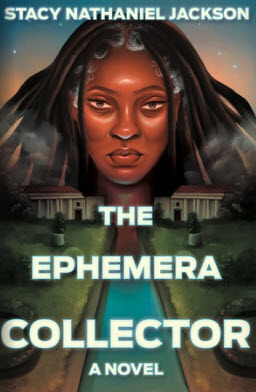Order The Ephemera Collector from local bookshops @: Bookshop.org, Greedy Reads, Lost City Books, Octavia’s Bookshelf, Mahogany Books, Politics & Prose, or wherever you buy books!

The Ephemera Collector Reviews
A gripping saga. People.
Ambitious . . . Jackson has arranged The Ephemera Collector as an archive in its own right, building a narrative out of fragments: transcripts, timelines, correspondence, images, documents . . . the radical heart of The Ephemera Collector [is] the notion that preservation matters. David L. Ulin, Alta.
An ambitious homage to Octavia Butler, this stunning near-future mosaic novel from debut author Jackson melds prose, poetry, memos, advertisements, and dream journal doodles… Jackson is an exciting new voice in Afrofuturism. Publishers Weekly starred review.
The scope of Jackson’s debut is breathtaking, from gripping suspense to serene contemplation to the scientific presentation of articles of history and imagination. Highly recommended for those who seek to understand the past and reimagine the future. Henry Bankhead, Library Journal, starred review.
The Ephemera Collector is page-turning, wildly creative, and smart as hell. This impressive debut novel reads in part like ‘if Octavia Butler lived through COVID,’ while also being something boldly original in its voice, vision, and genius. Remember the name Stacy Nathaniel Jackson—this is an author to watch. Mat Johnson, author of Invisible Things and Pym.
Both a masterful formal experiment and an exhilarating science fiction epic, The Ephemera Collector is a fractal of a novel—folding endlessly and effortlessly into itself in perfect synchronization with its parts: the journey of an archivist searching for meaning in the near future, a vision of humanity’s reckoning with its complex history and its ultimate fate, and a meditation on the complexity of memory, both human and cultural, that survives us in the objects left behind. Jinwoo Chong, author of Flux.
A transcendent map through the afropast, the afropresent and, of course, the afrofuture. I guarantee you’ve never read anything like it. Brilliant, bioluminescent work. Rion Amilcar Scott, author of The World Doesn’t Require You.
Reading The Ephemera Collector is like uncovering an archival box from the future! Stacy Nathaniel Jackson gives us the gift of Xandria Brown, a dedicated archivist with a unique perception of time, to weave a mind-bending and layered novel that takes us through the scorched earth of California, ocean civilizations, the cosmos, and even the inner lives of bots. Jackson’s powerful imagination blends technology, nature, and revolutionary vision to craft a blueprint for another world. Marytza K. Rubio, author of Maria, Maria.
A great novel. … The Ephemera Collector is as visual as it jolting. It is as scenic as it is glaring. It is both burden and sacrifice left at an altar. The work prompted me to close my eyes at moments in order to have solace with what was awaiting on the other side of the blk. Although this is a novel, there is clearly a poet conducting. Producing. Each sentence a brush swiped right, and right! Each turn a new choir. Warbling each page into its own new short time. avery r. young, author of neckbone: visual verses
A daring Afrofuturist debut that just scratches the surface of its own astonishing futures. Kirkus Reviews.
